Grace Elliot's Blog: 'Familiar Felines.' , page 17
May 29, 2013
Exeter Exchange: The London Menagerie
Did you know a seventeenth century edict prohibited exotic animals being exhibited in London's streets?
This ban wasn't out of concern for public safety, but because the privilege of showing rare animals (and the associated revenues) belonged to the keeper of his Majesty's lions, at the Tower of London. However, in a city hungry for novel entertainment, the showmen merely moved their lions and tigers to fairs and back alleys. But in 1793 one such itinerant showman, Gilbert Pidcock, dodged the issue and established a privately-owned menagerie which he opened to London's public.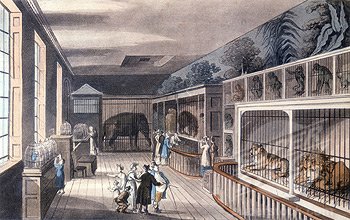 Inside the Exeter Exchange (also known as the Exeter 'Change)Gilbert Pidcock bought a four-storey building, the Exeter Exchange, in the Strand. It seems likely Pidcock wanted a place to overwinter his animals when not touring the country, and later realised there was a demand to exhibit in London all year round. His collection of exotic animals included a rhinoceros, kangaroo, zebra, lynx and some rare birds. Later he added tigers and an elephant. The latter is all the more surprising because the animals were kept indoors - on the first floor and above - the ground floor being occupied by shops.
Inside the Exeter Exchange (also known as the Exeter 'Change)Gilbert Pidcock bought a four-storey building, the Exeter Exchange, in the Strand. It seems likely Pidcock wanted a place to overwinter his animals when not touring the country, and later realised there was a demand to exhibit in London all year round. His collection of exotic animals included a rhinoceros, kangaroo, zebra, lynx and some rare birds. Later he added tigers and an elephant. The latter is all the more surprising because the animals were kept indoors - on the first floor and above - the ground floor being occupied by shops.
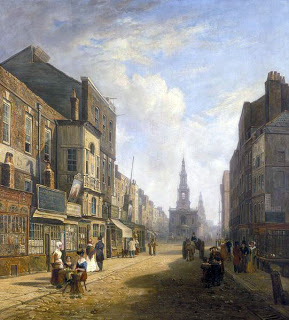 The Stand, London - in the 19th centuryPidcock's Menagerie grew in popularity at a time when the Tower Menagerie was shabby and in decline. Although situated in central London, it seems the city authorities were remarkably tolerant of Pidcock's establishment, even if newspapers frequently published letters complaining about jungle noises disturbing the peace, and noxious smells issuing from the building.
The Stand, London - in the 19th centuryPidcock's Menagerie grew in popularity at a time when the Tower Menagerie was shabby and in decline. Although situated in central London, it seems the city authorities were remarkably tolerant of Pidcock's establishment, even if newspapers frequently published letters complaining about jungle noises disturbing the peace, and noxious smells issuing from the building.
When Pidcock died in 1810 the menagerie eventually came under the ownership of Edward Cross (Pidcock's deputy and a skilled animal keeper) Cross had an eye for publicity and in adverts likened himself to:
"…that primeval collector of natural curiosities, Old Noah."
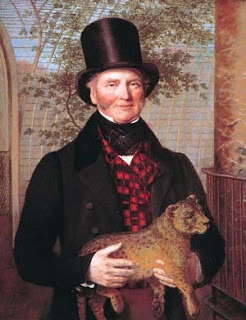 Edward CrossIndeed, Cross' collection included Chunee (an elephant), Nero (a large lion), four other lions, tigers, leopards, jaguars, antelopes, camels, llamas, bison and sea lions! That's not to mention a large collection of birds from ostriches, to five species of eagles, and vultures.
Edward CrossIndeed, Cross' collection included Chunee (an elephant), Nero (a large lion), four other lions, tigers, leopards, jaguars, antelopes, camels, llamas, bison and sea lions! That's not to mention a large collection of birds from ostriches, to five species of eagles, and vultures.
The menagerie was open 9 am to 9pm and it cost a shilling to see the three main exhibits, or two shillings to view everything. The most popular time to visit was at 8pm when the animals were fed and Chunee, the elephant rang a loud bell to signal the start of feeding time. "The Lords of Parliament and the lions of ExeterChange all dined at about eight."
William Clarke, journalist.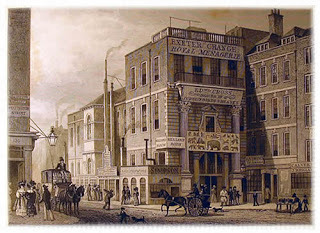 The Exeter Exchange - note the banner displaying exotic animals.And finally: one famous visitor to the menagerie was Lord Byron. He remarked that the face of the hippopotamus reminded him of Lord Liverpool (the Prime Minister) - [This seems rather dubious since no record exists of a hippo being exhibited] Other illustrious visitors included Princess Victoria (the future Queen), Robert Browning and Charles Dickens.
The Exeter Exchange - note the banner displaying exotic animals.And finally: one famous visitor to the menagerie was Lord Byron. He remarked that the face of the hippopotamus reminded him of Lord Liverpool (the Prime Minister) - [This seems rather dubious since no record exists of a hippo being exhibited] Other illustrious visitors included Princess Victoria (the future Queen), Robert Browning and Charles Dickens.
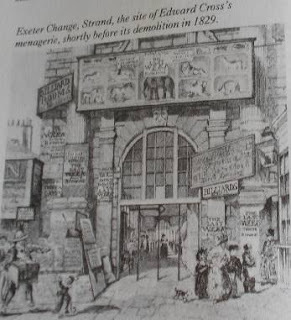 The caption reads :
The caption reads :
Exeter Change, Strand, site of Edward Cross's
menagerie, shortly before its demolition in 1829If you have enjoyed this post you may also be interested in:
The Wonderful Dog: Munito
The Learned Pig
This ban wasn't out of concern for public safety, but because the privilege of showing rare animals (and the associated revenues) belonged to the keeper of his Majesty's lions, at the Tower of London. However, in a city hungry for novel entertainment, the showmen merely moved their lions and tigers to fairs and back alleys. But in 1793 one such itinerant showman, Gilbert Pidcock, dodged the issue and established a privately-owned menagerie which he opened to London's public.
 Inside the Exeter Exchange (also known as the Exeter 'Change)Gilbert Pidcock bought a four-storey building, the Exeter Exchange, in the Strand. It seems likely Pidcock wanted a place to overwinter his animals when not touring the country, and later realised there was a demand to exhibit in London all year round. His collection of exotic animals included a rhinoceros, kangaroo, zebra, lynx and some rare birds. Later he added tigers and an elephant. The latter is all the more surprising because the animals were kept indoors - on the first floor and above - the ground floor being occupied by shops.
Inside the Exeter Exchange (also known as the Exeter 'Change)Gilbert Pidcock bought a four-storey building, the Exeter Exchange, in the Strand. It seems likely Pidcock wanted a place to overwinter his animals when not touring the country, and later realised there was a demand to exhibit in London all year round. His collection of exotic animals included a rhinoceros, kangaroo, zebra, lynx and some rare birds. Later he added tigers and an elephant. The latter is all the more surprising because the animals were kept indoors - on the first floor and above - the ground floor being occupied by shops.
 The Stand, London - in the 19th centuryPidcock's Menagerie grew in popularity at a time when the Tower Menagerie was shabby and in decline. Although situated in central London, it seems the city authorities were remarkably tolerant of Pidcock's establishment, even if newspapers frequently published letters complaining about jungle noises disturbing the peace, and noxious smells issuing from the building.
The Stand, London - in the 19th centuryPidcock's Menagerie grew in popularity at a time when the Tower Menagerie was shabby and in decline. Although situated in central London, it seems the city authorities were remarkably tolerant of Pidcock's establishment, even if newspapers frequently published letters complaining about jungle noises disturbing the peace, and noxious smells issuing from the building. When Pidcock died in 1810 the menagerie eventually came under the ownership of Edward Cross (Pidcock's deputy and a skilled animal keeper) Cross had an eye for publicity and in adverts likened himself to:
"…that primeval collector of natural curiosities, Old Noah."
 Edward CrossIndeed, Cross' collection included Chunee (an elephant), Nero (a large lion), four other lions, tigers, leopards, jaguars, antelopes, camels, llamas, bison and sea lions! That's not to mention a large collection of birds from ostriches, to five species of eagles, and vultures.
Edward CrossIndeed, Cross' collection included Chunee (an elephant), Nero (a large lion), four other lions, tigers, leopards, jaguars, antelopes, camels, llamas, bison and sea lions! That's not to mention a large collection of birds from ostriches, to five species of eagles, and vultures. The menagerie was open 9 am to 9pm and it cost a shilling to see the three main exhibits, or two shillings to view everything. The most popular time to visit was at 8pm when the animals were fed and Chunee, the elephant rang a loud bell to signal the start of feeding time. "The Lords of Parliament and the lions of ExeterChange all dined at about eight."
William Clarke, journalist.
 The Exeter Exchange - note the banner displaying exotic animals.And finally: one famous visitor to the menagerie was Lord Byron. He remarked that the face of the hippopotamus reminded him of Lord Liverpool (the Prime Minister) - [This seems rather dubious since no record exists of a hippo being exhibited] Other illustrious visitors included Princess Victoria (the future Queen), Robert Browning and Charles Dickens.
The Exeter Exchange - note the banner displaying exotic animals.And finally: one famous visitor to the menagerie was Lord Byron. He remarked that the face of the hippopotamus reminded him of Lord Liverpool (the Prime Minister) - [This seems rather dubious since no record exists of a hippo being exhibited] Other illustrious visitors included Princess Victoria (the future Queen), Robert Browning and Charles Dickens.
 The caption reads :
The caption reads :Exeter Change, Strand, site of Edward Cross's
menagerie, shortly before its demolition in 1829If you have enjoyed this post you may also be interested in:
The Wonderful Dog: Munito
The Learned Pig
Published on May 29, 2013 01:37
May 21, 2013
The 'Wonderful Dog' - Munito
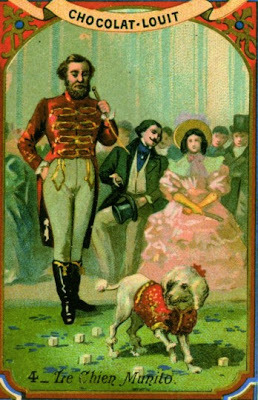 Munito- featured in an advert for chocolate! For a family night out in the 19th century, a trip to see Munito, the Wonderful Dog, was de rigour. Indeed, Munito was such a celebrity that he listed the Prince Regent and Duke of Yorkamongst his fans. This intelligent dog could perform tricks, do sums and spell using lettered cards, and he started his career in Paris, playing dominoes - which fascinated the Parisians who bet bonbons and cakes on the outcome of his games.
Munito- featured in an advert for chocolate! For a family night out in the 19th century, a trip to see Munito, the Wonderful Dog, was de rigour. Indeed, Munito was such a celebrity that he listed the Prince Regent and Duke of Yorkamongst his fans. This intelligent dog could perform tricks, do sums and spell using lettered cards, and he started his career in Paris, playing dominoes - which fascinated the Parisians who bet bonbons and cakes on the outcome of his games.His master was Signor Castelli, of whom little is known other he came from Italy and was thought to be in his 50's. Castelli spoke no English, only Italian and bad French, which he claimed the dog understood. The pair were often seen walking in London, with Castelli chatting away to the dog as if holding a conversation. But the dog, Munito, was not only intelligent but also brave. Apparently, he helped his master, Signor Castelli, rescue a woman from drowning and as a result was awarded an honoury medal by the Royal Humane Society.
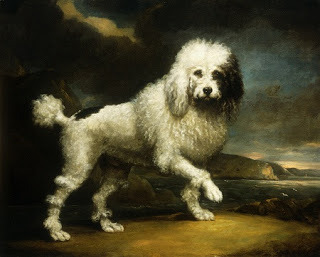 The original Munito looked similar to thisWater Spaniel or Poodle?Munito's breed is open to debate. Pictures of him from contempory posters show a medium sized, woolly dog with a sort of lion-clip. Apparently the dog's father was a hound and his mother, who Muntio was said to resemble, a water spaniel; the coat white all over except for a tan patch over his left eye. However, poodle breeders disagree and claim Munito for their own.Indeed, confusion may have arisen as it seems likely over the years, as many as 3 dogs going by the same name, performed in England and France. It seems likely the original Munito worked between 1816 and 1824, and Munito the poodle appeared in 1827 until the mid 1830's.
The original Munito looked similar to thisWater Spaniel or Poodle?Munito's breed is open to debate. Pictures of him from contempory posters show a medium sized, woolly dog with a sort of lion-clip. Apparently the dog's father was a hound and his mother, who Muntio was said to resemble, a water spaniel; the coat white all over except for a tan patch over his left eye. However, poodle breeders disagree and claim Munito for their own.Indeed, confusion may have arisen as it seems likely over the years, as many as 3 dogs going by the same name, performed in England and France. It seems likely the original Munito worked between 1816 and 1824, and Munito the poodle appeared in 1827 until the mid 1830's. 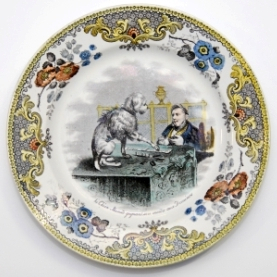 A plate showing Munito playing dominoes.How was Munito trained?The answer to how Munito was trained, was answered by, of all people, the novelist Charles Dickens. In 1867 Dickens wrote about having seen Munito's act, some 45 years earlier."… a learned dog was exhibited in Piccadilly - Munito … He performed many curious feats, answering questions, telling the hour of the day … picking out any cards called for from a pack on the ground.”Dickens set his observational skills to work and noticed how Munito walked around the cards sniffing them. The writer came up with an explanation as to how Munito did the trick.“We watched more narrowly … noticed that between each feat the master gave the dog some small bits … of food, and that there was a faint smell of aniseed from that corner of the room.”
A plate showing Munito playing dominoes.How was Munito trained?The answer to how Munito was trained, was answered by, of all people, the novelist Charles Dickens. In 1867 Dickens wrote about having seen Munito's act, some 45 years earlier."… a learned dog was exhibited in Piccadilly - Munito … He performed many curious feats, answering questions, telling the hour of the day … picking out any cards called for from a pack on the ground.”Dickens set his observational skills to work and noticed how Munito walked around the cards sniffing them. The writer came up with an explanation as to how Munito did the trick.“We watched more narrowly … noticed that between each feat the master gave the dog some small bits … of food, and that there was a faint smell of aniseed from that corner of the room.”
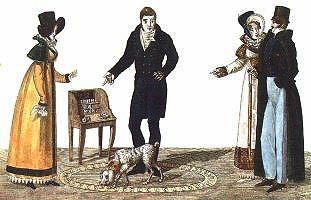 If you were wealthy enough, you could pay to have Munito
If you were wealthy enough, you could pay to have Munito perform in your own home.Indeed, Dickens noted a smell of aniseed coming from Castelli's waistcoat and concluded that he marked the relevant card with a small amount of aniseed on his thumb. However, another novelist, Jules Verne, who had also seen Munito (and alluded to him in 'A Captain at Fifteen') came up with a different explanation. He thought that Munito's master snapped a toothpick in his pocket when the dog sniffed the right card.
And finally, if you have enjoyed this post you can read about The Learned Pig here.
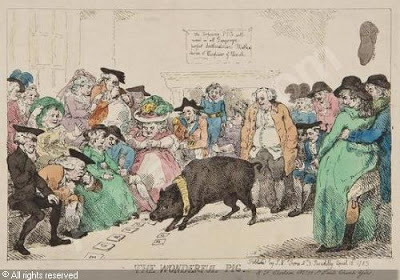 The Learned Pig - an illustration by Thomas Rowlandson
The Learned Pig - an illustration by Thomas Rowlandson
Published on May 21, 2013 11:52
May 19, 2013
Welcome! 'Beyond a Doubt' - author Felicia Rogers
Today, I'm delighted to welcome author, Felicia Rogers, to the blog. Felicia is a fellow Solstice author ('Beyond a Doubt' is with Astraea Press) and writer of historical fiction. Felicia is a lady with a generous heart and talented pen, and so it is with great pleasure that she announces #4 in her 'Renaissance Hearts' Series - such a beautiful cover!
Grace x
Beyond A Doubt, The Renaissance Hearts Series, Book Four
The end is finally here… Click for linkThe final chapter has been written for The Renaissance Hearts Series. What began with Sarra and Cedric in There Your Heart Will Be Also concludes with Bryce and Lucy in Beyond A Doubt. Set in the turbulent times of Mary I of England, or Bloody Mary, and Henry II of France, the fight for religious freedom abounds. Intrigue, loss of property, and loss of life rule the day. Follow the epic ending of a family’s struggle.
Click for linkThe final chapter has been written for The Renaissance Hearts Series. What began with Sarra and Cedric in There Your Heart Will Be Also concludes with Bryce and Lucy in Beyond A Doubt. Set in the turbulent times of Mary I of England, or Bloody Mary, and Henry II of France, the fight for religious freedom abounds. Intrigue, loss of property, and loss of life rule the day. Follow the epic ending of a family’s struggle.
Buy it Now on Amazon: http://tinyurl.com/c285w6u
Buy it Now on B&N: http://tinyurl.com/d429lom
SUMMARY
Bryce Cameron is finally going home. Years spent away have him longing for the craggy landscapes from his childhood.
Lucy Lombard is on a mission. The mantel she carries was never meant for her possession yet it has been passed to her anyway. Alone and in danger, Lucy stumbles onto her greatest find.
Rescuing Bryce is either a blessing or a curse but regardless time is running out. With Bryce's help can Lucy fulfill her mission or will she be too late?
****
See what others have said about the Renaissance Hearts Series.
“I really enjoyed this book. I do not typically favor historical romance, but the romance was not too mushy, and the historical was not too heavy! This was an enjoyable, delightful read!!!.” Taken from Rachel’s Amazon review on There Your Heart Will Be Also, Book One.
“If you are in for a good mystery with plenty of adventure, suspense & romance, you have come to the right place for this recommended novel because "By God's Grace" will give it all to you.” Taken from Arlean’s Amazon review of By God’s Grace, Book Two.
“Okay have to say this is my fav book so far in The Renaissance Heart Series! Felicia Rogersjust gets better!” Taken from Danielle William’s Amazon review of Labor of Love, Book Three.
Buy Beyond A Doubt on Amazon: http://tinyurl.com/c285w6u
Buy Beyond A Doubt on B&N: http://tinyurl.com/d429lom
Don’t forget the other books in the series. Available at Amazon, Barnes and Noble, and Astraea Press.
~There Your Heart Will Be Also, Book One~By God’s Grace, Book Two~Labor of Love, Book Three
ROMANCE AUTHORFelicia Rogers
 Author - Felicia RogersFelicia Rogers is an author of six novels and three novellas. When she's not writing, Felicia volunteers with the Girl Scouts of America, teaches at a local homeschooling group, hikes, and spends time with her family.
Author - Felicia RogersFelicia Rogers is an author of six novels and three novellas. When she's not writing, Felicia volunteers with the Girl Scouts of America, teaches at a local homeschooling group, hikes, and spends time with her family.
To find out more information about Felicia Rogersvisit the sites below. She loves hearing from readers.
Website: http://www.feliciarogersauthor.weebly.com Facebook: https://www.facebook.com/FeliciaRogersAuthorEmail: feliciarogersauthor@yahoo.comGoodreads: http://www.goodreads.com/author/show/4412925.Felicia_Rogers
Grace x
Beyond A Doubt, The Renaissance Hearts Series, Book Four
The end is finally here…
 Click for linkThe final chapter has been written for The Renaissance Hearts Series. What began with Sarra and Cedric in There Your Heart Will Be Also concludes with Bryce and Lucy in Beyond A Doubt. Set in the turbulent times of Mary I of England, or Bloody Mary, and Henry II of France, the fight for religious freedom abounds. Intrigue, loss of property, and loss of life rule the day. Follow the epic ending of a family’s struggle.
Click for linkThe final chapter has been written for The Renaissance Hearts Series. What began with Sarra and Cedric in There Your Heart Will Be Also concludes with Bryce and Lucy in Beyond A Doubt. Set in the turbulent times of Mary I of England, or Bloody Mary, and Henry II of France, the fight for religious freedom abounds. Intrigue, loss of property, and loss of life rule the day. Follow the epic ending of a family’s struggle.Buy it Now on Amazon: http://tinyurl.com/c285w6u
Buy it Now on B&N: http://tinyurl.com/d429lom
SUMMARY
Bryce Cameron is finally going home. Years spent away have him longing for the craggy landscapes from his childhood.
Lucy Lombard is on a mission. The mantel she carries was never meant for her possession yet it has been passed to her anyway. Alone and in danger, Lucy stumbles onto her greatest find.
Rescuing Bryce is either a blessing or a curse but regardless time is running out. With Bryce's help can Lucy fulfill her mission or will she be too late?
****
See what others have said about the Renaissance Hearts Series.
“I really enjoyed this book. I do not typically favor historical romance, but the romance was not too mushy, and the historical was not too heavy! This was an enjoyable, delightful read!!!.” Taken from Rachel’s Amazon review on There Your Heart Will Be Also, Book One.
“If you are in for a good mystery with plenty of adventure, suspense & romance, you have come to the right place for this recommended novel because "By God's Grace" will give it all to you.” Taken from Arlean’s Amazon review of By God’s Grace, Book Two.
“Okay have to say this is my fav book so far in The Renaissance Heart Series! Felicia Rogersjust gets better!” Taken from Danielle William’s Amazon review of Labor of Love, Book Three.
Buy Beyond A Doubt on Amazon: http://tinyurl.com/c285w6u
Buy Beyond A Doubt on B&N: http://tinyurl.com/d429lom
Don’t forget the other books in the series. Available at Amazon, Barnes and Noble, and Astraea Press.
~There Your Heart Will Be Also, Book One~By God’s Grace, Book Two~Labor of Love, Book Three
ROMANCE AUTHORFelicia Rogers
 Author - Felicia RogersFelicia Rogers is an author of six novels and three novellas. When she's not writing, Felicia volunteers with the Girl Scouts of America, teaches at a local homeschooling group, hikes, and spends time with her family.
Author - Felicia RogersFelicia Rogers is an author of six novels and three novellas. When she's not writing, Felicia volunteers with the Girl Scouts of America, teaches at a local homeschooling group, hikes, and spends time with her family.To find out more information about Felicia Rogersvisit the sites below. She loves hearing from readers.
Website: http://www.feliciarogersauthor.weebly.com Facebook: https://www.facebook.com/FeliciaRogersAuthorEmail: feliciarogersauthor@yahoo.comGoodreads: http://www.goodreads.com/author/show/4412925.Felicia_Rogers
Published on May 19, 2013 00:30
May 15, 2013
The Foundling Hospital: A Child's View
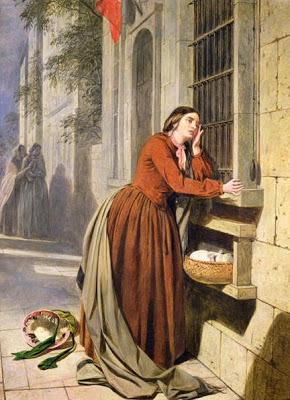 A mother leaving her baby at the Foundling Hospital, Paris.
A mother leaving her baby at the Foundling Hospital, Paris.Original canvas can be seen at the Foundling Museum, London.My previous two posts looked at the Foundling Hospital, London, and how it looks today, and also an exhibition of tokens on display at what is now the Foundling Museum. But if, as a Georgian child, you were taken in by the hospital, what sort of upbringing could you expect?
Once admitted each child was given a new name. At first the hospital's governors lent their own names, but this turned out to be confusing for some children who held false hopes of illustrious parentage.
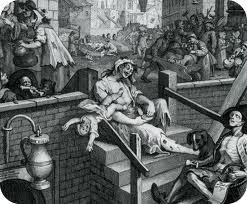 Gin Lane by the 18th century artist, William Hogarth -
Gin Lane by the 18th century artist, William Hogarth - a perilous time to be a child. The babies were breast fed and their first two to four years of life were likely spent in the countryside, farmed out to a wet nurse. At around about three years, they returned to London where they were inoculated against smallpox - a major innovation of the day. It seems an emphasis was placed on healthy living because they were encouraged to play outside.
"Exercised in the open air …as may contribute to their health and induce a habit of active hardiness."
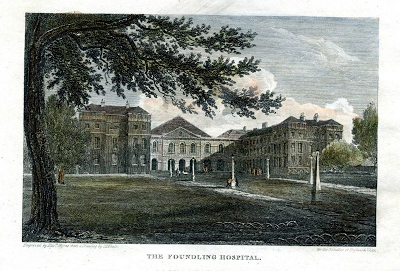 The Foundling Hospital offered a better future than that of
The Foundling Hospital offered a better future than that ofan abandoned child living on the streetsHowever, even play was done with an eye to future work. For instance boys played with bats and balls.... and javelins because they might help them find a job!
"Inure them for a proper slight in the throwing a harpoon in the Greenland [whale] fishery."
Boys stayed in education for longer than girls, who at the age of six took on housekeeping duties around the hospital in order to make them:"Useful servants to such proper persons as may apply for them."
Boys faired a little better in terms of having a longer childhood, but at the age of twelve were often sent out into the world:"At twelve years the boys be sent to sea or husbandry[agricultural labour] …to have in readiness boys instructed in gardening for such persons as may incline to take them into their service."
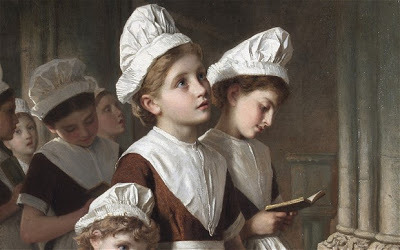 Foundling children during a church service.
Foundling children during a church service. The original painting is on display at the Foundling Museum, LondonWhilst at the hospital the children wore a uniform designed by the Georgian artist, William Hogarth, who was a patron of the society. The girls wore brown serge dresses with a stiffened bodice but no stays, and the boys wore jackets and breeches, cheered by touches of red.
The food was: "plain and simple…their bread coarse and their drink water."Bread was made on the premises, perhaps making it more healthy than the adulterated and contaminated fair available in the city. However, the understanding of the nutritional needs of children was almost none existent and despite the governors best intentions, many of their wards suffered from scurvy or rickets.
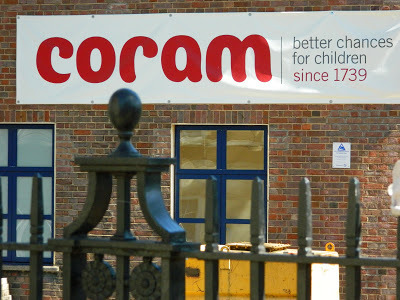 Thomas Coram established the Foundling Hospital in the 18th century,
Thomas Coram established the Foundling Hospital in the 18th century, and his work for the welfare of children continues in his name today.Despite everything, a child raised by the Foundling hospital had a better start in life than many poor children: well trained, presentable and immune to smallpox - they stood a good chance of finding employment. The only downside was the hospital's finite resources. It's a telling and sad fact that in July 1749, out of 83 applications for mercy, only 20 babies were taken in.
If you have found this post interesting you may want to read:
London Then and Now: The Foundling Hospital
The Foundling Hospital: Fate, Hope and Charity
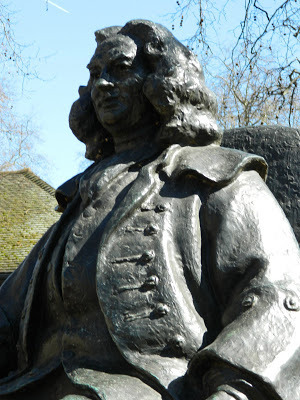 The statue of Thomas Coram, erected in his honour
The statue of Thomas Coram, erected in his honour outside the Foundling Museum
Published on May 15, 2013 01:22
May 8, 2013
The Foundling Hospital's Exhibition: Fate, Hope and Charity
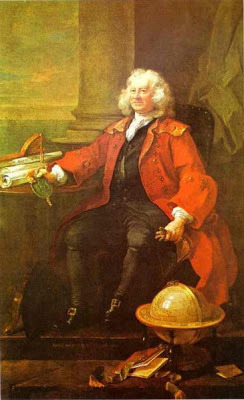 Hogarth's portrait of Captain Thomas CoramThe Foundling Hospitalcame about through the determination of Captain Thomas Coram.
Hogarth's portrait of Captain Thomas CoramThe Foundling Hospitalcame about through the determination of Captain Thomas Coram. Born in Lyme Regis, England, Coram was well acquainted with the sea and much of his early life was involved with ships or shipping. But what Coram cared about was poverty, especially of those least able to help themselves - the abandoned or orphaned children he saw dying on city streets. For nearly two decades he waged a campaign to rouse the consciences of the wealthy and establish a place where such unfortunates could be raised in safety.
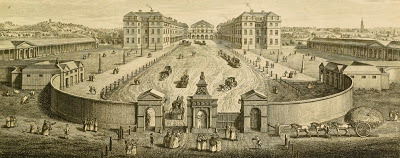 Aerial view of the Foundling Hospital circa 1753In 1739, he succeeded andKing George II granted a Royal Charter giving Coram the authority to establish: "Ahospital for the maintenance and education of exposed and deserted young children,"Eventually known as the Foundling Hospital, in 1740's the hospital (the word used in a wider sense meaning 'hospitality') found a home in Bloomsbury, London.
Aerial view of the Foundling Hospital circa 1753In 1739, he succeeded andKing George II granted a Royal Charter giving Coram the authority to establish: "Ahospital for the maintenance and education of exposed and deserted young children,"Eventually known as the Foundling Hospital, in 1740's the hospital (the word used in a wider sense meaning 'hospitality') found a home in Bloomsbury, London. 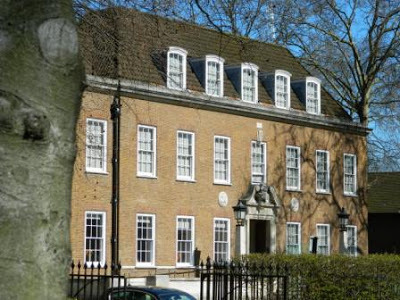 The Foundling Museum, Brunswick Square, London.
The Foundling Museum, Brunswick Square, London.The museum is home to artefacts and art work associated with the hospital.Coram's intention was that parents and offspring could be reunited when the former's circumstances improved. With this aim he instituted detailed record keeping - quite a contrast to the parish parochial records."All persons who bring children are requested to affix on each child some particular writing or other distinguishing mark or token so that the child may be know hereafter if necessary."
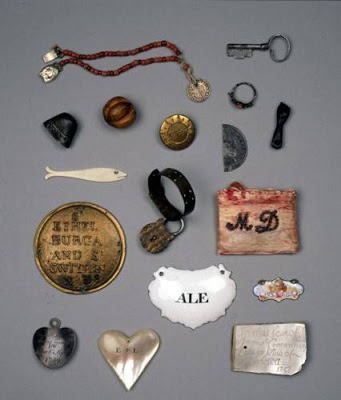 A variety of tokens on exhibit at the Foundling Museum.
A variety of tokens on exhibit at the Foundling Museum.'Fate, Hope and Charity - the exhibition'
Click for link.
Photo the property of the Foundling Museum.Indeed, some of these tokens are currently on display at the Foundling Museum in an exhibition: Fate, Hope and Charity. They form a moving testament to the despair that drove women to give up their babies. From scraps of fabric to gambling tokens, from delicate rings to notes written on death row, each object speaks of untold heart ache and desperation. In return for the token and her baby, the mother was issued with a detailed receipt which she was urged to keep safe:"It is desired that it [the receipt] be carefully kept, that it may be produced if the child should at any time be claimed."
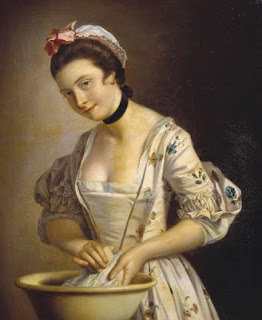 A rather well-dressed Georgian laundry maid.Babies were given up for any number of reasons. Perhaps the most plaintive read:"Seduc'd and reduc'd"- perhaps written by a maid who would lose her position, and means of making a living, if her illegitimate babe was discovered. But married woman were also driven to abandonment, from the soldier's wife with nine children to support, whose husband died and left her penniless, to the woman writing in her prison cell after she was sentenced to hang.
A rather well-dressed Georgian laundry maid.Babies were given up for any number of reasons. Perhaps the most plaintive read:"Seduc'd and reduc'd"- perhaps written by a maid who would lose her position, and means of making a living, if her illegitimate babe was discovered. But married woman were also driven to abandonment, from the soldier's wife with nine children to support, whose husband died and left her penniless, to the woman writing in her prison cell after she was sentenced to hang. 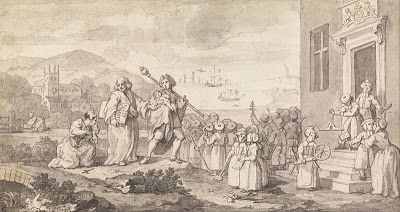 Children hoping to be admitted Foundling Hospital.On admittance the children were given a different name - the new one carefully recorded against the old, in case a parent later returned. The very first admitted were named after Thomas Coram and his wife, Eunice. Initially, the governors leant their names to children but this proved a mistake when those same children came of age and had mistaken hopes of high parentage. Safer, more none committal names became the vogue, such as Robin Hood, or Elizabeth Foundling.
Children hoping to be admitted Foundling Hospital.On admittance the children were given a different name - the new one carefully recorded against the old, in case a parent later returned. The very first admitted were named after Thomas Coram and his wife, Eunice. Initially, the governors leant their names to children but this proved a mistake when those same children came of age and had mistaken hopes of high parentage. Safer, more none committal names became the vogue, such as Robin Hood, or Elizabeth Foundling. 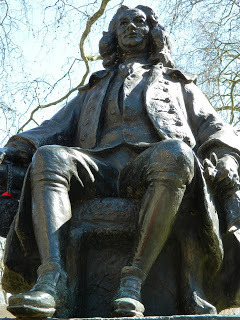 The imposing statue of Thomas Coram,
The imposing statue of Thomas Coram,sited outside the Foundling Museum.Perhaps even more upsetting are the tales of those parents who returned, years later, to reclaim their children - only to be told the babe had died shortly after admittance. One can not imagine the hope that sustained those women over the years, only to be dashed at what should have been the happiest moment. If you are within traveling distance of London, I can heartily recommend a visit to: Fate, Hope and Charity. - but hurry, the exhibition ends on May 19th!
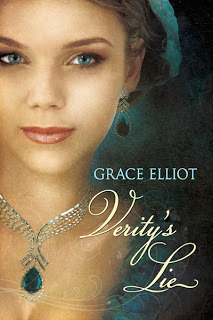 Forthcoming release, Verity's Lie,
Forthcoming release, Verity's Lie,in part features foundling children.
If this post has whetted your appetite, see also:London Then and Now: The Foundling Hospital
Published on May 08, 2013 00:31
April 24, 2013
London Then and Now: The Foundling Hospital
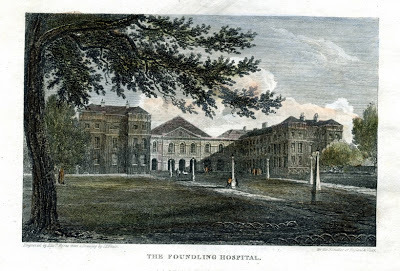 The Foundling Hospital -
The Foundling Hospital - The word 'hospital' was used in a wider sense than today,
to indicate 'hospitality'.Those of you who follow my blog will know I like to visit historic sites and compare the appearance of the environs with how it looked in the past. I find this fascinating because a historic building may be perfectly preserved but English Heritage or the Historic Royal Palaces have no control on what goes around it.
This weekend I revisited one of my favourite places, the Foundling Museum, to see an exhibition of tokens (I digress...more in a future post) and on a beautiful sunny day I took a walk around the environs of Brunswick Square to compare 'then and now'.
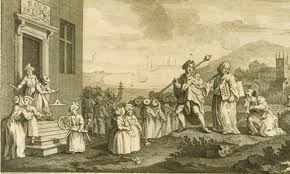 A scene depicting a queue of children hoping to be admitted to the Foundling Hospital.
A scene depicting a queue of children hoping to be admitted to the Foundling Hospital.Note the rural setting and open countryside.
In 1761 a 56 acre site was purchased in Bloomsbury, London, on which to build the Foundling Hospital. The building was completed in 1752 and general reception of children started in 1756. Bloomsbury was chose since it was on the edge of London and opened onto fields and was therefore beneficial to the health of the foundling children.
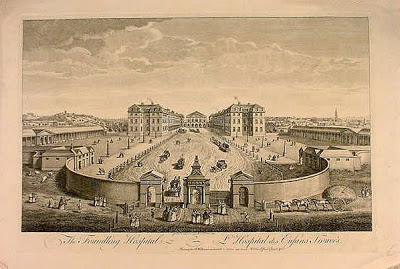 This print of the Foundling Hospital (18th century) is notable for the open
This print of the Foundling Hospital (18th century) is notable for the openspace around it.
In the modern day, the noise and bustle of London presses in from all sides, but despite some horrendous architecture some precious patches of green space remain. Directly opposite the Foundling Museum (alas, not the original building) is Brunswick Square.
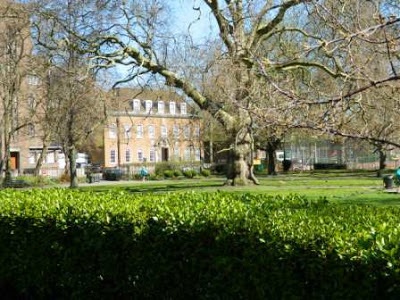 Foundling Museum (central building) as seen from the
Foundling Museum (central building) as seen from the far side of Brunswick Square (behind me is a road) Although the original building no longer exists, a replacement was built in keeping with the character of the first.
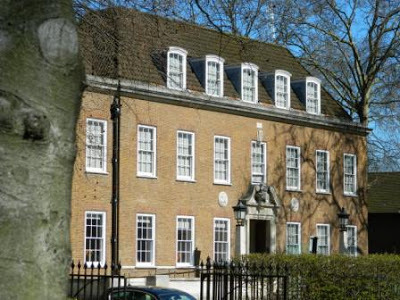 The Foundling Museum - now home to a collection of works of art,
The Foundling Museum - now home to a collection of works of art, including those by William Hogarth, an 18th century patron.However, not all neighbouring buildings are so sympathetically designed - take for instance the immediate neighbour (imagine the above photo extending to the left of the tree)
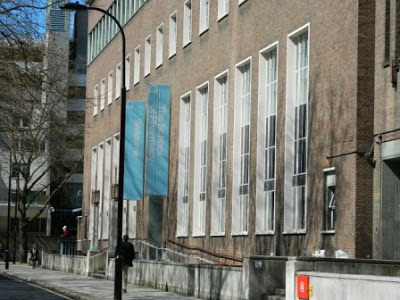 The London School of Pharmacy - adjacent to the Foundling MuseumJust emerging to the left of the London School of Pharmacy, on the other side of the square, is another modern building - a student hall of residence.
The London School of Pharmacy - adjacent to the Foundling MuseumJust emerging to the left of the London School of Pharmacy, on the other side of the square, is another modern building - a student hall of residence.  The west side of Brunswick Square.So what about to the rear of the Foundling Museum? I found a delightful patch of green that was once a cemetary, St George's Gardens.
The west side of Brunswick Square.So what about to the rear of the Foundling Museum? I found a delightful patch of green that was once a cemetary, St George's Gardens.  Over the wall and through the trees, is the back of the
Over the wall and through the trees, is the back of the Foundling Museum
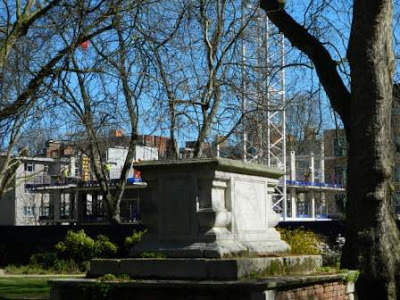 However, this once peaceful space is even now being hemmed in
However, this once peaceful space is even now being hemmed inby redevelopement. And as I turned to leave St George's Garden, what did I see but the Post Office Tower (or whatever they call it these days!) A reminder how small London is and how close everything is together.
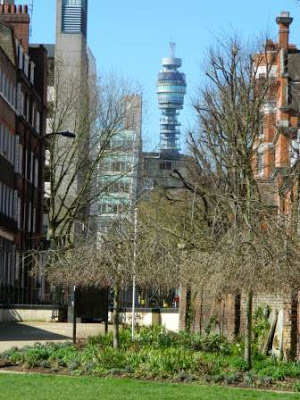 The Post Office Tower.Next week: more about the history of foundlings and the hospital.
The Post Office Tower.Next week: more about the history of foundlings and the hospital.
Published on April 24, 2013 12:29
Yesterday was St George's Day
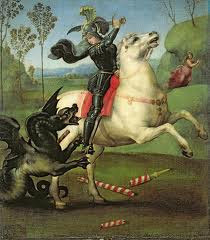 Classic image of Saint George on his white charger
Classic image of Saint George on his white chargerslaying the dragonYesterday I met my mother and father for lunch. One of the local shops was flying the flag of St George and Mum commented, "They like to make a lot of St George's Day in Pinner." (She went on to say, "But they had the wheelbarrow race on Saturday," - which left me puzzled. Wasn't St George mounted on a horse, I don't remember anything about wheelbarrows!)
Anyhow, it came as a surprise to learn it was St George's Day and it seems I'm not alone. Apparently, we English are reknown for our lethargy when it comes to celebrating the national saint's day. So to redress the balance, here are some facts about St George.
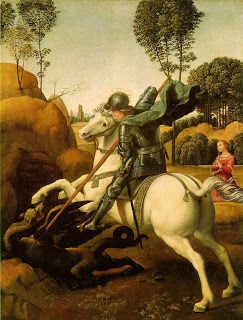 St George by Raphael- In 1350 King Edward III named George as England's Patron Saint, when he formed the Order of the Garter in Saint George's name.
St George by Raphael- In 1350 King Edward III named George as England's Patron Saint, when he formed the Order of the Garter in Saint George's name. - George is attributed with killing the dragon on the appropriately named, Dragon Hill in Uffinton, Berkshire. Legend has it that no grass will grow where the dragon's blood was spilt (hmm, perhaps a dragon was slain in my back garden.)
- It is unlikely George actually slayed a dragon, (indeed it is unlikely George even set foot in England) but he was first credited with doing this in the 12th century. In the Middle Ages the Devil was commonly represented as a dragon, so one explanation could be that the legend was a figurtive story of good vs evil.
- Another explanation for the story of George, on a white horse, killing the dragon, is that it was a christianisation of the Greek legend of Perseus rescuing Andromeda from a sea monster near Lydda.
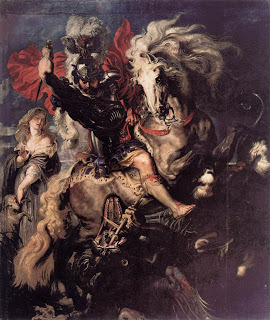 Saint George by Peter Paul Rubens
Saint George by Peter Paul Rubens- could almost be a zombie in there somewhere...- Debate rages as to who George was, but the most likely explanation is that he was born in Cappadocia, Turkey and was a high-ranking officer in the Roman army. The Emperor Diocletian tortured George to make him deny his faith in Christ, but he wouldn't capitulate and as result was beheaded near Lydda in Palestine. The church in Rome bearing his name is said to contain his severed head.
- Apart from withstanding torture for his faith, the religious acts attributed to George are scarce. In fact, Pope Gelasius described him thus:
"... whose name is rightly reverenced amongst us, but whose actions are known only to God."
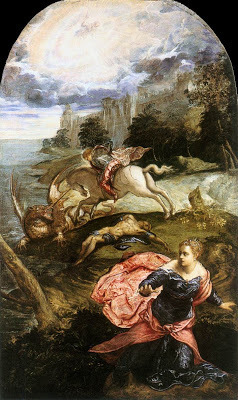 Tintoretto's versiou of Saint George-And finally, one person who had more cause than most to remember the date of St George's day was William Shakespeare. Reputedly, the great baird was born on (1564), and also died on (1614), St George's day.
Tintoretto's versiou of Saint George-And finally, one person who had more cause than most to remember the date of St George's day was William Shakespeare. Reputedly, the great baird was born on (1564), and also died on (1614), St George's day. So - did you remember St George's day, or like me, did you forget...or were you too busy racing wheelbarrows (really must ask my Mum about that one!)
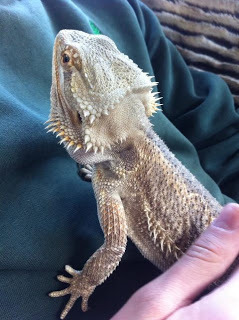 And this is our very own dragon (of the Bearded variety)-
And this is our very own dragon (of the Bearded variety)-strictly no dragon slaying in our house ...only feeding, bathing
and cuddles!
Published on April 24, 2013 01:43
April 21, 2013
The Great Bed of Ware - by guest Deborah Swift
A 16th century bed to sleep fifty-two by Deborah Swift.
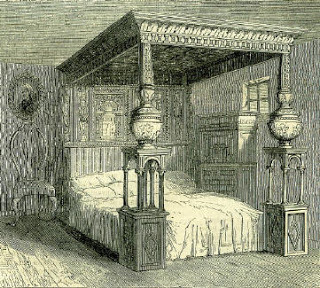 In the 1590’s what better advertising gimmick could you have for your inn or public house than a giant four poster bed that could sleep as many as twenty six people?
In the 1590’s what better advertising gimmick could you have for your inn or public house than a giant four poster bed that could sleep as many as twenty six people?The Great Bed of Ware is an extremely large oak bed, made in the realm of Elizabeth I, that was originally housed in the White Hart Inn in Ware, England. Ware was a popular overnight stop-over for pilgrims on the route from London to the shrine at Walsingham, and had many inns by the end of the 16th century.
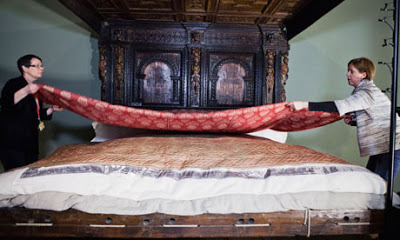 Photo courtesy of the Guardian newspaper.Billed as able to sleep 12, the fame of the Great Bed of Ware spread so much that travellers often chose the town of Ware to break their journey simply to spend one night in the bed. People who slept there marked the occasion by carving their initials on the bed or adding their red wax seals, which are still visible on the bedposts and headboard today. Apparently 26 butchers and their wives spent the night in it for a bet in 1689, (52 people!) but it was also popular with the rich and famous - in 1596 Prince Ludwig of Anhalf-Kohten visited Ware and slept there, and in 1610 Prince Ludwig Friedrich of Württemburg stayed in it.
Photo courtesy of the Guardian newspaper.Billed as able to sleep 12, the fame of the Great Bed of Ware spread so much that travellers often chose the town of Ware to break their journey simply to spend one night in the bed. People who slept there marked the occasion by carving their initials on the bed or adding their red wax seals, which are still visible on the bedposts and headboard today. Apparently 26 butchers and their wives spent the night in it for a bet in 1689, (52 people!) but it was also popular with the rich and famous - in 1596 Prince Ludwig of Anhalf-Kohten visited Ware and slept there, and in 1610 Prince Ludwig Friedrich of Württemburg stayed in it.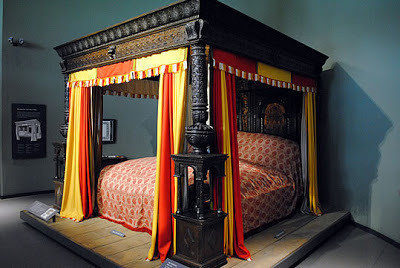 The Great Bed dressed with fine drapesThe bed is 3.38m long and 3.26m wide (ten by eleven feet), and is carved with acanthus leaves and strapwork patterns derived from the Renaissance tradition. Originally it would have been brightly painted, and traces of the painting can still be seen on the figures on the bed-head. The marquetry panels which are inlaid in the headboard are copies of the work of Dutch artist Hans Vredeman de Vries but the panels were probably carved by Londoncraftsmen. The frame of the bed was built by Jonas Fosbrooke from Hertfordshire.
The Great Bed dressed with fine drapesThe bed is 3.38m long and 3.26m wide (ten by eleven feet), and is carved with acanthus leaves and strapwork patterns derived from the Renaissance tradition. Originally it would have been brightly painted, and traces of the painting can still be seen on the figures on the bed-head. The marquetry panels which are inlaid in the headboard are copies of the work of Dutch artist Hans Vredeman de Vries but the panels were probably carved by Londoncraftsmen. The frame of the bed was built by Jonas Fosbrooke from Hertfordshire.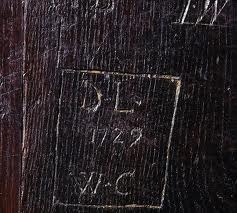 One example of the initials carved into
One example of the initials carved intoThe Great BedDespite its huge size, the bed travelled about quite a lot. In the 19th century it was situated at the Saracen’s Head, another inn at Ware, but it also had brief stays at The George, The Crown or the Bull. In 1870, William Henry Teale, the owner of the Rye House, acquired the bed and used it in his pleasure garden as a visitor attraction. In 1931, it was acquired by the Victoria and Albert Museum, in London, where it is now one of their most prized exhibits. The most famous mention of it during the Elizabethan period is in Shakespeare's Twelfth Night of 1601 : Toby Belch ...and as many lies as will lie in thy sheet of paper, although the sheet were big enough for the bed of Ware in England...'.
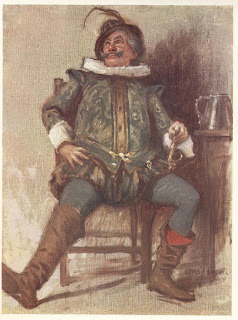 Toby BelchThanks to Grace for hosting me. Now I need to find another 52 historical novelists to sneak into the V&A for a night of bed-time reading so we can break the world record for the number of people in the bed. Any takers?
Toby BelchThanks to Grace for hosting me. Now I need to find another 52 historical novelists to sneak into the V&A for a night of bed-time reading so we can break the world record for the number of people in the bed. Any takers?Interesting Daily Mail article about the bed: http://www.dailymail.co.uk/femail/article-2128651/Great-Bed-Wares-229-200-V-A-Museum-original-resting-place.html
Deborah’s blog www.deborahswift.blogspot.com
Deborah is author of The Gilded Lily and The Lady’s Slipper, both on kindle special offer this month
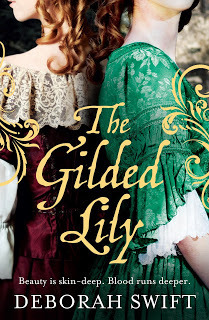 Click for linkDeborah Swift's captivating writing makes you feel as if you're in Restoration London alongside the two lead characters of this excellent historical novel. Highly recommended. --The Bookbaghttp://www.amazon.co.uk/The-Gilded-Lily-Deborah-Swift/dp/0330543431/
Click for linkDeborah Swift's captivating writing makes you feel as if you're in Restoration London alongside the two lead characters of this excellent historical novel. Highly recommended. --The Bookbaghttp://www.amazon.co.uk/The-Gilded-Lily-Deborah-Swift/dp/0330543431/Thank you Deborah, for such a fascinating post. I remember visiting William Wordsworth's home in the Lake District and seeing his four poster bed. It was surprisingly small (apparently people tended to sleep sitting up (?!) and so the beds were shorter - so the Bed of Ware, must have seemed even more enormous in its day.
Thank you for visiting,
Grace x
Published on April 21, 2013 00:30
April 17, 2013
Superstitions: Never Bring a Lily Indoors
 In Greek legend lilies were formed from the spilt breast milk of the goddess Hera when she was tricked into nursing the infant, Heracles. The babe was pulled from her breast and some of the milk stained the heavens as the Milky Way, whilst part fell to earth as the lily. The flower was seen as a symbol of fecundity and purity and in ancient cultures brides wore a crown of lilies woven with wheat, to bring the blessing of fertility to the marriage.
In Greek legend lilies were formed from the spilt breast milk of the goddess Hera when she was tricked into nursing the infant, Heracles. The babe was pulled from her breast and some of the milk stained the heavens as the Milky Way, whilst part fell to earth as the lily. The flower was seen as a symbol of fecundity and purity and in ancient cultures brides wore a crown of lilies woven with wheat, to bring the blessing of fertility to the marriage.
 The Milky Way
The Milky WayThe lily also has a number of associations in Christian legend. The first was that lilies came about from Eve's tears in the Garden of Eden. Later on the flower had other associations, such as representing the Virgin Mary's tears or to have arisen from Jesus' sweat the night before his the crucifixion, and are therefore a symbol of resurrection. It is because of this that many churches are decorated with lilies at Easter time.
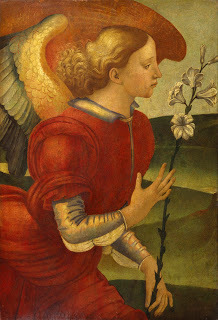 Legend has it that the Archangel Gabriel presented the
Legend has it that the Archangel Gabriel presented theVirgin Mary with a spray of lilies, at the annunciation.Intriguingly, the ancient Roman's placed a lily in the hands of the deceased when they were buried, to signify rebirth. This tradition was adopted by the early Church but later became corrupted as a Christian symbol of death. Because of this association it is considered bad luck to bring lilies indoors. However, if you are an animal lover, more specifically a cat owner, it is worse than bad luck to have lilies in the house, it can be fatal to your pet.
When a cat brushes past a lily, the pollen is readily transferred to her fur. When the cat grooms herself and ingests the pollen, she is unwittingly poisoning herself. The pollen is 'nephrotoxic', or damaging to the kidney, and will rapidly send her into renal failure. If your cat has contact with lily pollen, immediately wipe her coat with a damp cloth to remove as much as possible, stop her licking her fur and then phone your vet for advice.
 Being fastidious groomers, if a cat gets pollen on herself, she will
Being fastidious groomers, if a cat gets pollen on herself, she will wash it off - possibly with fatal consequencesOther Lily Legends
In the 18th century having lilies indoors was said to 'procure wakefulness'.Lilies were thought to cure sorry by causing loss of memoryChinese herbalist thought lilies had to power to cause the birth of a son if the flower was worn in the woman's girdle during pregnancy.It is unlucky to have an even number of flowers in a bouquet, this is associated with wreathes and death. In Victorian flower language, a white lily meant purity and gave the message "It's heavenly to be with you", whilst an orange lily represented hatred.
 A happy cat is ...one without lilies in the house.
A happy cat is ...one without lilies in the house.
Published on April 17, 2013 01:28
April 10, 2013
10 Questions: Hope Tyler of "Hope's Betrayal"
Today's blog post is by way of a game - passed to me by Deborah Swift, author of, The Gilded Lily. In turn I pass it on to author, Maria Grace (see previous post to learn more about the Ms Grace's work)
10 questions - Hope Tyler of 'Hope's Betrayal'
Favorite Colour:
Hope's favorite colour is the opalescent green-blue of the sea on a sunny day.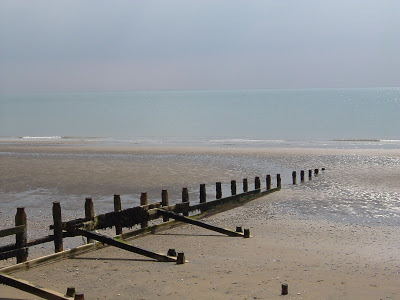 The coast of the Isle of Wight - a view Hope would
The coast of the Isle of Wight - a view Hope would
have been familiar with.Favorite Animal:
Hope has known hunger and deprivation and therefore has a practical attitude to animals. That said, she is very fond of Jasper, Lady Constance's spaniel, especially as he brought help when she had been kidnapped.
 Jasper is a Cavalier King Charles Spaniel
Jasper is a Cavalier King Charles Spaniel
Photo courtesy of Trisha Spears.(click for link)Favorite Number:
Four.
Favorite Non-alcoholic Drink: Tea. Hope has smuggled all manner of illicit substances into the country, anything from coffee to lace, and tobacco to tea. Of those that she tried, tea is by far away her favorite.
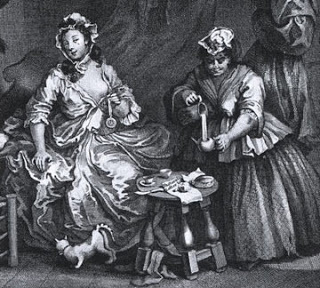 Hogarth print of ladies taking tea.
Hogarth print of ladies taking tea.
Tea was highly taxed and so many consumers drank contraband leaves.Facebook or Twitter?Hope is a woman of action and would enjoy Twitter on so many levels. Undoubtedly, she would have a network of fellow smugglers who would keep each other informed of the latest movements of the Revenue Officers. Also, she is not a woman to waste words and would appreciate the brevity of the messages.
Her Passion:Justice. Hope lives in a world of social inequality, where the rich can openly drink the tea she has smuggled, but she could hang for supplying them. Hope does not want to break the law, but grinding poverty means that to feed her family she has no choice.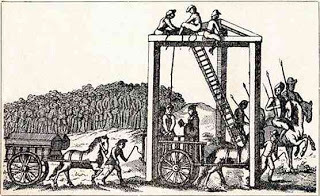 The penalty if caught smuggling were harsh.Giving or getting presents: Hope has an open heart and a generous spirit - she loves to give and is embarrassed to receive.
The penalty if caught smuggling were harsh.Giving or getting presents: Hope has an open heart and a generous spirit - she loves to give and is embarrassed to receive.
Favorite Day: Hope has learnt to take pleasure in the small things in life. Her favorite day would be warm, with the sun glinting off the sea and plentiful fish to be caught.
Favorite Flowers: A carpet of woodland bluebells. Photo courtesy of Keith Hulbert
Photo courtesy of Keith Hulbert
(click for link)Favourite Book: Hope rarely has the time to read, but if she did, she'd appreciate the irony and humour of Ms. Austen's novels.
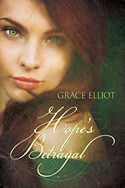 Click for link.This game was passed to me by Deborah Swift and I am passing it on to Maria Grace.
Click for link.This game was passed to me by Deborah Swift and I am passing it on to Maria Grace.
I hope you have enjoyed this insight into Hope's character! Why not leave a comment and share some of your favourite things!
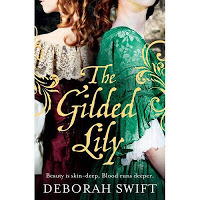 Click for link
Click for link
10 questions - Hope Tyler of 'Hope's Betrayal'
Favorite Colour:
Hope's favorite colour is the opalescent green-blue of the sea on a sunny day.
 The coast of the Isle of Wight - a view Hope would
The coast of the Isle of Wight - a view Hope wouldhave been familiar with.Favorite Animal:
Hope has known hunger and deprivation and therefore has a practical attitude to animals. That said, she is very fond of Jasper, Lady Constance's spaniel, especially as he brought help when she had been kidnapped.
 Jasper is a Cavalier King Charles Spaniel
Jasper is a Cavalier King Charles SpanielPhoto courtesy of Trisha Spears.(click for link)Favorite Number:
Four.
Favorite Non-alcoholic Drink: Tea. Hope has smuggled all manner of illicit substances into the country, anything from coffee to lace, and tobacco to tea. Of those that she tried, tea is by far away her favorite.
 Hogarth print of ladies taking tea.
Hogarth print of ladies taking tea. Tea was highly taxed and so many consumers drank contraband leaves.Facebook or Twitter?Hope is a woman of action and would enjoy Twitter on so many levels. Undoubtedly, she would have a network of fellow smugglers who would keep each other informed of the latest movements of the Revenue Officers. Also, she is not a woman to waste words and would appreciate the brevity of the messages.
Her Passion:Justice. Hope lives in a world of social inequality, where the rich can openly drink the tea she has smuggled, but she could hang for supplying them. Hope does not want to break the law, but grinding poverty means that to feed her family she has no choice.
 The penalty if caught smuggling were harsh.Giving or getting presents: Hope has an open heart and a generous spirit - she loves to give and is embarrassed to receive.
The penalty if caught smuggling were harsh.Giving or getting presents: Hope has an open heart and a generous spirit - she loves to give and is embarrassed to receive.Favorite Day: Hope has learnt to take pleasure in the small things in life. Her favorite day would be warm, with the sun glinting off the sea and plentiful fish to be caught.
Favorite Flowers: A carpet of woodland bluebells.
 Photo courtesy of Keith Hulbert
Photo courtesy of Keith Hulbert(click for link)Favourite Book: Hope rarely has the time to read, but if she did, she'd appreciate the irony and humour of Ms. Austen's novels.
 Click for link.This game was passed to me by Deborah Swift and I am passing it on to Maria Grace.
Click for link.This game was passed to me by Deborah Swift and I am passing it on to Maria Grace.I hope you have enjoyed this insight into Hope's character! Why not leave a comment and share some of your favourite things!
 Click for link
Click for link
Published on April 10, 2013 03:29
'Familiar Felines.'
Following on from last weeks Halloween posting, today's blog post looks at the unwanted image of cats as the witches familiar - from the Norse Goddess Freya to lonely women in the middle ages.
The full Following on from last weeks Halloween posting, today's blog post looks at the unwanted image of cats as the witches familiar - from the Norse Goddess Freya to lonely women in the middle ages.
The full post can found at:
http://graceelliot-author.blogspot.com
...more
The full Following on from last weeks Halloween posting, today's blog post looks at the unwanted image of cats as the witches familiar - from the Norse Goddess Freya to lonely women in the middle ages.
The full post can found at:
http://graceelliot-author.blogspot.com
...more
- Grace Elliot's profile
- 156 followers



